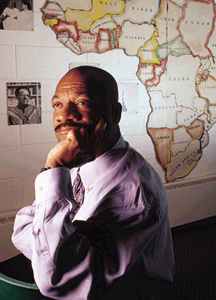A Selective (Old) Penn Chronology 1902-1918
Our first Centennial timeline covers 1902 to 1918, when Old Penn becomes the Gazette (and World War I ended).
As the 20th century begins, Penn has established the “modern collegiate ideal” at its West Philadelphia campus with the simultaneous opening in 1896 of the first stages of the Quadrangle Dormitories; Franklin Field (commitment to intercollegiate athletics); and Houston Hall (extra-curricular activities and student life). Much of the funding for the new buildings is provided by Charles C. Harrison C1862, the provost.
By 1902 there are 281 members of the faculty, and total enrollment for the 1902-03 academic year is 2,517, including undergraduate enrollment of 1,113 and graduate and professional enrollment of 1,404. Of the total student population, 1,776 are residents of Pennsylvania, 161 are from New Jersey, and 109 from New York. Undergraduate tuition is $200; room and board is $250.

1902

The first issue of Olde Penn, eight tabloid-newspaper pages long, is published on November 14. The founding editor is George E. Nitzsche L1898, who doubles as the University’s publicity agent. Subscription price is $1 a year; single copies sell for 5 cents.
1903

The Department of Greek performs Iphigenia Among the Taurians (in Greek) on April 28-29 at the Academy of Music; Old Penn (which has dropped the e) covers the performance and runs a photo of the cast, which includes Ezra Pound C’05 G’06 in drag as a member of the Chorus. Franklin Field’s original wooden stands are replaced with brick, with seating capacity for 20,000.
1904
U.S. President Theodore Roosevelt speaks at the Washington’s Birthday festivities. The School of Medicine leaves Medical Hall and occupies the new Medical Laboratories (now John Morgan) Building on Hamilton Walk; decorations include Thomas Eakins’ 1889 painting “The Agnew Clinic,” whose central figure is Dr. David Hayes Agnew M1838. The rapidly expanding Wharton School takes over the old building, renamed Logan Hall.
1904-1905
The football team amasses a record of 24-0-1 over two seasons; opponents score a total of 37 points against the Quakers.
1906
The School of Engineering and Applied Science occupies its new Towne Building, on Smith Walk, between 33rd and 34th streets. On November 3, Old Penn serendipitously runs photos of future Modernist giants (and good friends) Ezra Pound and William Carlos Williams M’06 Hon’52 on its front page—the former in the Iphigenia Among the Taurians cast and Williams as Polonius in Mask & Wig’s 1905 production of Mr. Hamlet of Denmark.
1908
The University awards a Bachelor of Arts degree to Pauline Wolcott Spencer on June 17, and the Bachelor of Science degree to Zeta Berenice Cundey. They are the first women to complete the requirements for the bachelor’s degree at Penn through the College Courses for Teachers program. The football team has its last undefeated season until 1947. Student registration is now 4,556.
1909
Old Penn shrinks to magazine size, with a cover and better-quality paper. Some 5,000 full-time students are registered.
1910

The University Museum dig at Nippur, led by Dr. Hermann Hilprecht, professor of Assyriology, discovers what is called the oldest version of the Flood story on a tablet from the temple library. That season’s Mask & Wig play, The Desert of Mahomet, revolves around a Penn Assyriology student’s discovery of a “cuneiform tablet in the celebrated Nippur Library.”
1910-1911

Charles C. Harrison resigns as provost and Dr. Edgar Fahs Smith, professor of chemistry, is named his successor.
1913
The Central Committee of the Alumni merges with the General Alumni Society, thereby creating a single, unifed alumni organization. On April 19, Old Penn publishes photographs by Eadweard Muybridge and an article titled “The Evolution of Moving Pictures.” The Women’s Dormitory is opened in two houses at the southwest corner of 34th and Sansom streets, and the new School of Veterinary Medicine building at 39th and Pine streets is completed. Work begins on the dental school’s Thomas W. Evans Museum & Dental Institute at 4oth and Spruce.
1914
The College faculty abolish the requirement of classical Greek for the Bachelor of Arts degree. The School of Education (now the Graduate School of Education) is founded. The old Dental Hall is renovated, renamed Alfred C. Harrison Hall (now Hayden Hall), and turned over to the Department of Architecture (now the Graduate School of Fine Arts). The Great War begins in Europe.
1915

The University dismisses Scott Nearing C’06, an assistant professor in the Wharton School, for disseminating socialist-tinged views, despite a favorable recommendation by the faculty. The ensuing nationwide uproar prompts the trustees to adopt amendments to the University’s statutes which introduced the modern tenure system for University faculty.
1916

The last issue edited by George Nitzsche is published on June 24. On December 22, after the trustees “temporarily suspended the publication of this magazine,” the first issue of the 1916-1917 year is published, under a new editor: Edward R. Bushnell C’01. The subscription price is $2 a year; single copies are 10 cents. Student registration tops 9,000.
1917
On January 1, in the football team’s only Rose Bowl appearance, Penn falls to Oregon, 14-0. America enters the Great War in April, and registration drops by as much as a quarter as students enter the armed services.
1918
On February 1, Old Penn becomes The Pennsylvania Gazette. On November 2, the Great War ends.




